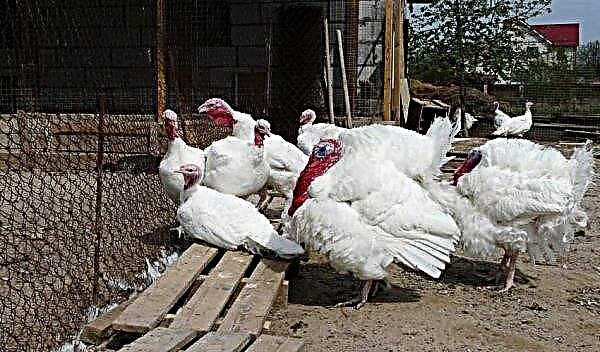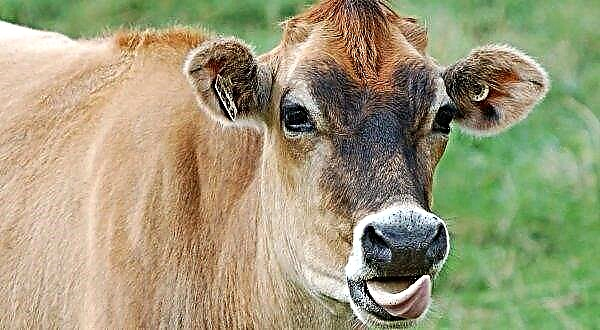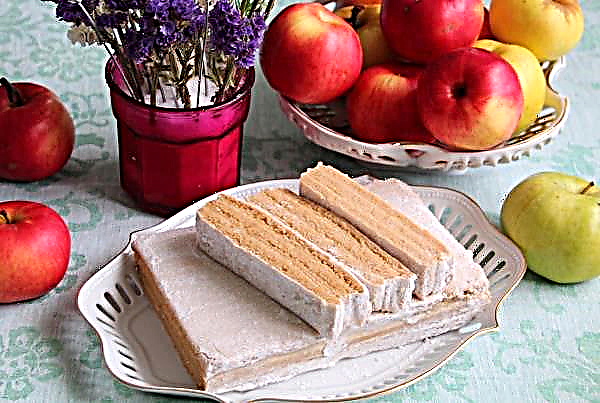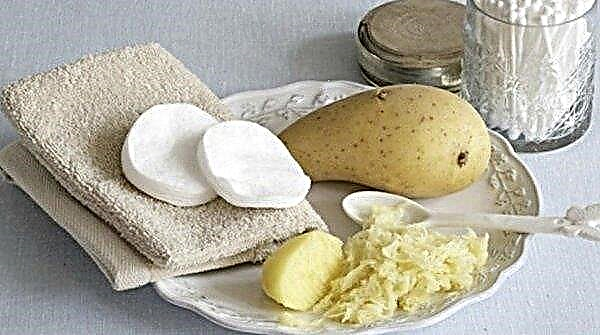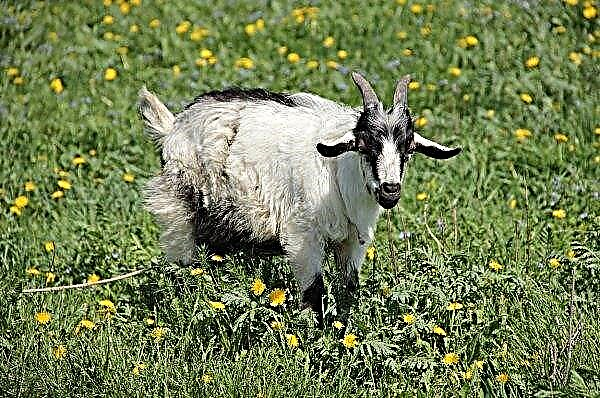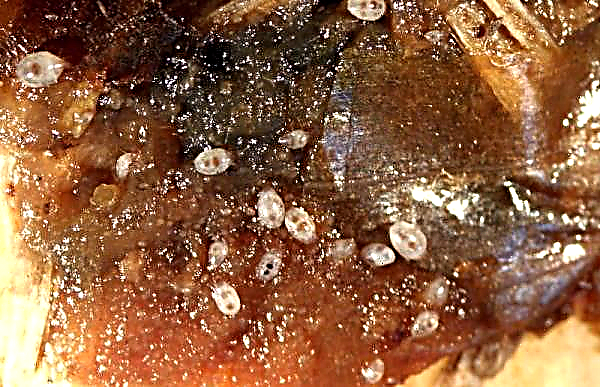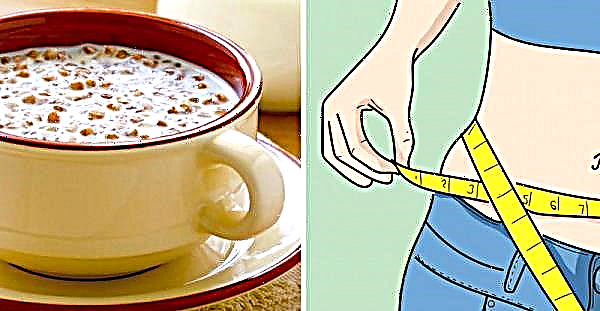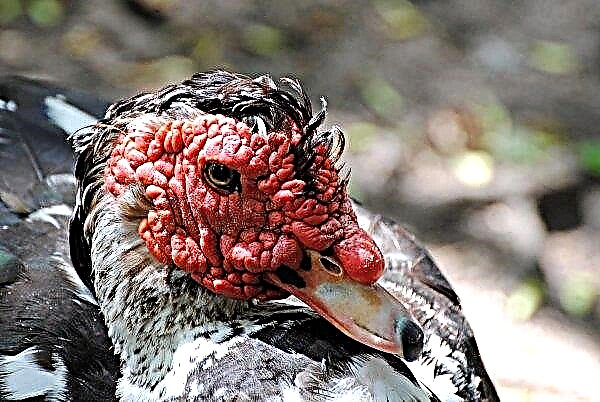Hogweed begonia is valued in floriculture due to its luxurious carved foliage, which stands out among other decorative-leafy congeners with a variety of colors and light hairiness. The plant is picky in the care and at room conditions well builds a lush bush. About the features of this flower and the intricacies of its growing at home - later in the article.
Houseplant Description
In the Brazilian subtropics, which are considered the birthplace of culture, Begonia heracleifolia is found in the form of annual and perennial grasses, shrubs, and also shrubs.
Its typical characteristics are:
- powerful creeping or tuberous rhizome;
- thick green or cherry-brown stems with a long thick pile;
- asymmetric palmate leaves, the length of which in the natural habitat can reach 30 cm (their color can be saturated green, cherry-red or red with a brown tint);
- long peduncles with small delicate pink irregularly shaped flowers.
Did you know? The Belgians have a tradition once every 2 years on the Brussels Grand Dance Square to spread a floral carpet of 800 thousand varieties of begonias. Moreover, the organizers of the action with the help of different color buds "draw" historical compositions, landscapes of Versailles gardens and all kinds of faces of saints.
The hogweed begonia was first discovered in 1864 by French researchers during a scientific expedition in Brazil. The species got its botanical name due to its pronounced resemblance to the foliage of hogweed, common in the temperate zone of the Eurasian continent. At home, with proper care, the plant does not exceed half a meter height, but builds up a dense decorative bush, which will worthily decorate any interior.
Optimal conditions for growing
In order for indoor flowers to harmoniously develop and delight with the diversity of their large foliage, they need to create conditions close to the range. We are talking about the appropriate temperature and humidity conditions, as well as lighting and soil composition.

Soil requirements
The quality of the substrate is one of the most important factors that determine the growth of a plant, so loose and nutritious soil with excellent water and air permeability is preferred for planting home begonia.
In the case of self-preparation of the earthen mixture, it is recommended to combine equal parts of fertile black soil (extracted from a depth of 20 cm), deciduous soil and high peat. In order to prevent the rapid evaporation of moisture, it is advisable to add a little vermiculite to the soil mixture. And do not forget about the drainage layer, which should not exceed 10% of the volume of the landing tank.
Keep in mind that young seedlings are distinguished by special requirements for potted soil, therefore, when rooting them, in no case do not ram the top layer. The greater its friability, the better the germ will develop.
Important! When planting begonia, be sure to disinfect its root system with any fungicide (Euparen, Fundazol).
Lighting and daylight
A begonia pot is best placed in a well-lit area with diffused rays.. For this, it is not necessary to choose the sides of the southern orientation, since the plant is afraid of the scorching sun. He will be comfortable in rooms whose windows face east and southwest.
If the flowerpot is in partial shade, its foliage will become more dense and covered with brown-red streaks. Such an arrangement does not at all harm the splendor of the begonia crown and the size of its leaf plates. It is desirable that the daylight hours for the plant last at least 12 hours, otherwise its biomass will lose volume and fade.
Temperature and humidity
In conditions of excessive heat or cold, it is impossible to achieve a luxurious appearance of a flower. In the first case, the tips of its leaves will dry out and begin to curl, and in the second, the flowerpot will stop its development and may die at all.
The optimum temperature for the harmonious development of the culture is + 18 ... + 22 ° C at a humidity of 60%. It is important that in the winter, when the period of stagnation begins, the thermometer in the room does not fall below the minimum markings. Otherwise, begonia sensitive to cold will disappear.
In the warm season, especially in hot weather, it is recommended to spray the air near the plant, protecting it from water. Drops falling on foliage and inflorescences are fraught with the appearance of not aesthetic brown spots.
Keep in mind that this variety is hygrophilous. But of great importance is a sense of proportion. With excess moisture, rot quickly develops on the roots of the flower, and it is far from always possible to save it. Experienced flower growers advise periodically humidifying the air in the room or putting a container filled with water near the pot.
Important! Small, wide pots of clay or ceramics are preferred for planting begonias of any kind.
Features of home care
Favorable conditions for growing do not guarantee success, since the observance of agricultural technical requirements in the care plays an important role for all representatives of the Begoniev family. In this aspect, the grower should pay attention to the timeliness and quality of top dressing, the frequency of moisturizing procedures, replanting and pruning excessively overgrown bushes.
Top dressing
Fertilizing for the flower is relevant only during the period of active vegetation, in spring and summer. The hogweed species responds well to a solution of chicken manure, diluted in a proportion of 1:50, as well as to universal mineral complexes intended for indoor plants.
According to the recommendations of the manufacturers, fertilizers are dissolved in water for irrigation and used no more than 1 time per week. With intensive growth of green biomass, 14-day pauses can be made. In autumn and winter, a one-time feeding per month is advisable to stimulate vitality.
Watering
Soil moistening of hogweed begonia is carried out only after complete drying of the surface soil layer. Between waterings, they systematically moisten the air with a spray gun or fill the pan with water. To avoid excessive moisture, it is filled with pebbles. Please note that spraying the flower is shown only on hot summer days, as well as when it is placed close to the heating system batteries.
For irrigation, only room temperature water that has settled for 24 hours is suitable. In order to avoid the development of putrefactive infections on the roots, young seedlings are advised to moisten by directing a stream of watering can to the edge of the pot.
Did you know? The largest begonia in Europe is located in the French port of Rochefort. Over its 33-year history, she has collected about 500 species of these flowers and 900 hybrids.
Pruning
While the culture is young, there is no urgent need to remove its stems. The procedure is relevant as the bush grows, when the old foliage falls, and not the aesthetic basal part begins to be exposed. Elongated stems are carefully cut with a knife disinfected in a weak solution of potassium permanganate, leaving small “stumps” with 1-2 scars from leafy cuttings. Pruning begonia is anti-aging, as it stimulates the awakening of sleeping kidneys.
Transfer
Young seedlings should be replanted every year, and more mature specimens in a year or two. The best period for transplanting indoor plants is considered autumn or spring. The main thing is not to do this from the second decade of October to mid-February. Then the flower is at rest, due to which it is limited to watering and feeding.
Video: Hogweed Begonia Transplant
In cases where there are problems during the cultivation and you notice signs of root rot, an unplanned transplant is required. Be sure to remove the affected areas from the root system and disinfect it with potassium permanganate or fungicidal preparations.
When planting begonias, it is strictly forbidden to deepen the tubers strongly. Their surface should slightly peek out of the soil. It is also not recommended to cover young plants with plastic wrap or transparent dishes to create a greenhouse effect. Such actions will provoke the accumulation of excess moisture, as a result of which the flowerpot will die.
Important! The room in which begonia is located must be periodically ventilated, avoiding drafts.
Begonia breeding
There are several ways to get a new seedling of hogweed begonia.
Leaf with stem

This option is considered the simplest. For its implementation, it is enough to cut spring and summer cuttings from the old bush, the length of which reaches 10-15 cm. After that, the place of the slices is slightly dried or resorted to preliminary rooting of the workpieces in containers with water.
Some gardeners advise to plant the lower parts of the cuttings with growth stimulants before planting (Ecosil, Kornevin). After the manipulations have been done, the seedlings are deepened into a soil mixture or river sand prepared in advance.
The sprout is required to be kept at a temperature condition of + 22 ... + 25ºС and air humidity of 60%. A month later, when small roots appear, the grafted cuttings are planted in separate containers.
We advise you to read about the varieties of decorative and deciduous begonias - Mason begonias.
Leafy cuttings
For such reproduction, you will need to select a large, full-fledged leaf. Its plate is spread on a flat surface and with a sharp blade, cuts are made in the direction from the center to the segments. In each formed part you should have several vascular veins.
After that, the workpiece is transferred to wet soil and the lower edges are slightly deepened. In this case, it is appropriate to cover the planting with a film so that later on, young cuttings form under the leaf. Planting should be kept at a temperature of + 20 ... + 23ºС, moderately moisturizing and periodically ventilating. After 4 weeks, small shoots are expected to appear in the vein cut sites. They are transplanted into new containers.
 a - a scheme for cutting cuttings from a leaf, b - rooting of a leaf cuttings, c - propagation of broad leaved begonias with a whole leaf; 1 - cuts of veins from the lower side of the leaf, 2 - the formation of young plants in cuts of the veins
a - a scheme for cutting cuttings from a leaf, b - rooting of a leaf cuttings, c - propagation of broad leaved begonias with a whole leaf; 1 - cuts of veins from the lower side of the leaf, 2 - the formation of young plants in cuts of the veins
Dividing the bush
Due to the fact that the hogweed variety is characterized by increased growth in breadth, in spring, when replanting a mature pot, you can divide its bush into several parts. It is important that each of them has an individual root system. The division is carried out with a sharp knife. After that, the places of cuts are treated with crushed charcoal and planted in separate pots.
Important! To keep the begonia tubers better preserved, place them in a dark place where the temperature corresponds to + 10 ... + 12°C. In such conditions, they can lie up to 2 months.
Seeds
This method requires patience and effort, which is why it is often used by lovers of botanical experiments. It is advisable to practice it if necessary, propagation of flowering varieties of begonia. Self-collection of planting material is inefficient, so experts advise using purchased grains of varietal mixtures.
For planting, it is necessary to prepare the soil from autumn so that it warms up well. At the end of February, you can begin to sow the hogweed variety. Seeds are dipped in a weak solution of potassium permanganate. Washed with cold water and incubated for several hours in a solution of growth stimulant. After that, they are placed on the surface of a moistened substrate and lightly sprinkled with fresh soil.
It is important to cover the landing with polyethylene to create a greenhouse effect. In such conditions, at a temperature of + 22 ... + 25ºС, regular moistening and good lighting, the first shoots will appear in 20–25 days.
When the first pair of leaves is formed on young shoots, seedlings can be dived into separate pots. After the procedure, it is recommended that they be kept in a temperature range of + 17 ... + 18ºС with limited watering.
Possible growing problems
It is much easier to care for decorative leafy begonias than for flowering ones. However, gross violations of agricultural regulations often lead to diseases and plant death.
Did you know? The first begonia was discovered in 1689 by a French expedition, which began its journey from the port city of Rochefort in France to the West Indies. The flower was named in honor of the governor of the Antilles, Michel Begon, who led a group of researchers.
The dysfunctional content of the flower is indicated by:
- paled leaves and overly elongated shoots (to correct the situation, it is required to improve lighting, including resorting to artificial light sources);
- brown and withered leaf edges (such signs occur in conditions of excessive heat and moisture deficiency);
- the appearance of brown, dried patches on brightened leaf plates (These are sunburns that are the result of improper placement of the pot);
- lack of growth or poor development (may be the cause of the development of putrefactive infections in the soil due to its overmoistening, as well as bacterial, fungal infection or pests).

Diseases
Pathogenic microflora appears when moisture stagnates in a flower pot in winter and its deficit in summer, and inappropriate temperature conditions contribute to this.
Most often, hogweed begonia suffers from:
- Powdery Mildew. It manifests itself in a light coating, darkening over time. The fungicides “Skor”, “Fundazol”, “Fitosporin”, “Agate” are treated.
- Root and leaf rot. Signs are inhibition in the development of the plant, the appearance of dark spots on the foliage or in the root zone. If a disease is detected at the initial stages of development, immediate optimization of the temperature-humidity regime and removal of damaged areas is recommended. It is possible that the flower will be transplanted into new soil with preliminary cleaning and disinfection of the root system. In advanced cases, it is necessary to save the plant by rooting its cuttings (they are cut from healthy stems).
- Bacterial and annular spotting. A sign of pathology is brown, brown-red, white blotches on the foliage, which can be characterized by a blurred and clear outline of the edges. Treatment is carried out with the fungicidal preparations Trichodermin, Oxychom, Albit, Fitosporin.
Did you know? Residents of the mountain Himalayas use begonia flowers and leaves as a culinary seasoning.
Pests
Improper conditions of maintenance and care attract harmful insects to the plant.
Leaf-begonia can be attacked by:
- mealybug;
- whiteflies;
- aphid;
- spider mite.
You can get rid of parasites by spraying the bush with insecticides based on biological and chemical substances. The preparations Aktara, Aktellik, Fitoverm, Bi-58 have proven themselves well. New "," Decis "," Thunder-2 ". Be prepared that in cases of severe infection, a single treatment will be powerless and require 2–4 repetitions of the procedure throughout the week.
Pest control may take several months, so do not forget to periodically inspect the plant. When using insecticides and fungicides, it is important to observe the rules of personal safety and, when calculating the required dosage, take into account the recommendations of the manufacturers.
Hogweed begonia is favorably distinguished by its decorativeness and relative undemandingness.Breeding this variety will be possible even for a beginner grower.


